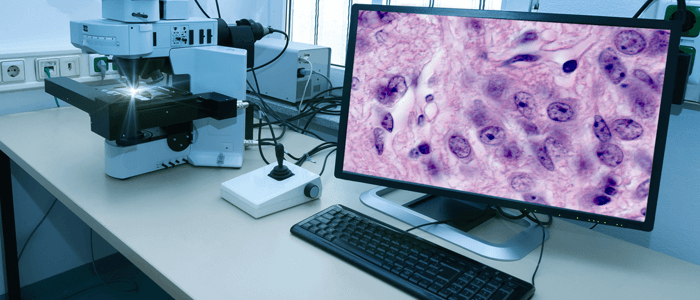
Digital pathology is pitched as the answer to improved patient care, efficient diagnosis and effective monitoring, but its future relies on the tech industry’s ability to keep up. Is it ready for the challenge?
Pathology is the study of disease and, despite the robots whizzing around surgeries and the exoskeletons walking the wards, the methods used haven’t changed much in the past 100 years. Pathologists are still largely working in labs using microscopes and stains to diagnose chronic conditions. But digital pathology is about to change that.
Digital pathology is what you might expect – using computer technology to acquire, manage, share and analyse pathology information. Once the slides are prepared, an electronic microscope digitalises the slide using scanning technology. This results in a high-resolution image that is then uploaded, analysed and shared using digital pathology software.
Digital pathology has significant potential for the healthcare industry, bringing benefits including:
The ease and speed of capturing, sharing and analysing slides using digital technology increases efficiencies in the pathology department. This reduces the current pressures caused by a worldwide lack of pathologists and speeds up disease diagnosis.
The ability to quickly share slides with different experts and collaborate with global professionals leads to quicker and better patient care, and the use of digital slides reduces errors caused by breakage and misidentification.
The digital storage of slides enables pathologists to quickly compare cases, conduct long-term predictive analysis and support the development of junior specialists. Furthermore, image recognition systems could one day be used to identify and detect diseases, while AI algorithms can learn to spot links between cases not easily found by the human eye.
The use of algorithms to analyse digital slides brings the potential for significant advances now and in the future. Computerised quantitative analysis can be used to improve prognostic scores and reduce human error – a recent study achieved an approximate 85% reduction in human error when combining deep learning and pathologist diagnoses.
But, the realisation of these benefits and the future of digital pathology rests on the tech industry’s ability to overcome some towering hurdles. These include:
The impact on a lab’s current systems, networks and bandwidth are significant. Image quality is essential to the success of digital pathology and IT departments need to ensure their systems can cope.
The workflow of digital pathology is quite different from that of traditional pathology. Standardised workflows need to be developed to determine when slides are digitalised, at what point pathologists conduct their own examination and how to embed these algorithms into the clinical workflow.
The high resolution of the digital slides takes up an enormous amount of space. Consideration of how these images are stored and shared is essential, alongside the security of this information.
Thousands of algorithms need developing for digital pathology to work, yet we don’t yet have large enough data sets to develop deep learning algorithms. Not only that, but there will be a significant validation process to ensure the tech is working as expected.
And finally, the perception of digital pathology might be one of the hardest hurdles to overcome. While we know AI to be a job enhancer, not remover, some pathologists are concerned about the future of roles, especially given the potential digital pathology gives for remote working.
Despite these hurdles, it’s without a doubt that digital pathology will play a significant role in the future of medicine. If you are looking for a new role, or your business needs to hire the top tech talent, feel free to schedule a call with me to discuss further.